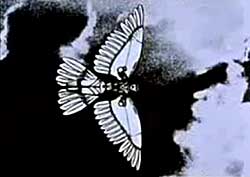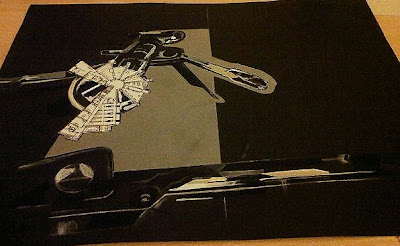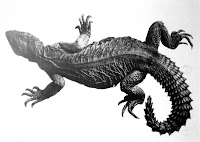This question initially prompted me to investigate the most easily assumed answer; the definition of drawing itself. The current shorted Oxford dictionary defines drawing as 'the formation of a line by drawing some tracing instrument from point to point of a surface; representation by lines, delineation as distinguished from painting, the arrangement of lines which determine form.' Yet I began to question whether drawing can actually be defined.
Drawing is probably a lot of things to a lot of different people, in a sense it is used to communicate. A mode of thinking, an extension. Drawing is much more than simply a visual issue, it is an investigation. Knowing what is drawing for is much harder to define.
There are many different reasons why people draw;
- to visualise thought and work something out.
- to provide a pattern to follow or give instructions how to make something.
- to help clients visualise what is proposed.
- to describe or record something.
- to give pleasure as ends in themselves.
As I recognised the reasons why and what we used drawing for, I considered my own uses for drawing and why I use it in my work.
All jewellery design originates from an inspirational source, whether its a technique or material or visual information from drawing images or objects. By gathering information from a wide range of sources it can spark interest to investigate further. As jewellery is a three-dimensional medium, it is beneficial to study 3-D forms as to aid understanding how form can be expressed and how shapes and lines intersect with one another in relation to each other and within space.
By keeping a sketchbook as a sort of visual diary to record the things you find and particular aspects to be found interesting when working with a project in mind the research takes on a particular direction which may lead to several paths; some may be dead ends, but others can provide inspiration for years to come. Drawing is a vital design tool as it provides a means of exploring and recording ideas in a descriptive medium. A silversmith/jewellery designer may use several types of drawing as part of the design process from sketchbooks to exploratory drawing to detailed technical drawing and final presentation drawing. The method of illustration that is chosen will depend on the particular project and client, but clear communication is the key whatever the style .

My most successful drawing to date within the Silversmithing and Jewellery department at GSA is in the form of Maya, a 3 Dimensional animation software(See above centre). It was used with the help of my friend Saswat Satadaryshi, who is a current student of MDES in Animation at GSA. As my final design was proposed on a larger scale with specific lighting involved. This form of precise animation included all the relevant information, including the scale of the piece. Presentation drawings such as this are most useful when working to commission so that the client can see accurate representations of the piece before it is made. Successful design realization can give a silversmith/jeweller a powerful voice and means of expression. The transition from a two-dimensional drawings to three-dimensional objects can be a challenge, so making models of a piece is a key part of the process, in both technical and aesthetic aspects of designing.
 This is a still from Jan Lenica's animation, 'Labyrinth' and a link to watch the video. I find his work completely captivating. The way he uses collage, drawing and moving image to build up utterly surreal worlds and characters is so skilful that this work transcends the label of a cartoon and exists as a piece of fascinating, beautiful and complete artwork in its own right. Animation is such an exciting tool for elevating a drawing and exploring its potential meanings and emotional impact. The soundtrack in this piece adds to and enforces the atmosphere of unease and heightens the feeling of tension, which is particularly apparent when you understand the context in which the film was made. This Kafka-esque, politically charged animation was made in the wake of De-Stalinisation in Poland, with artists finding a new freedom of expression which had been denied to them by Communist censorship, and with an influx of state-sponsored art under the new government, people could now discuss experiences of hardship and oppression. And I suppose through collage and drawing as opposed to a live action film, the artist is free to be imaginative and expressive with use of metaphor, without the constraints of contemporary technologies. I think that films like this have far more charm, aesthetic value and feeling of authorship than modern cartoons made using CGI.
This is a still from Jan Lenica's animation, 'Labyrinth' and a link to watch the video. I find his work completely captivating. The way he uses collage, drawing and moving image to build up utterly surreal worlds and characters is so skilful that this work transcends the label of a cartoon and exists as a piece of fascinating, beautiful and complete artwork in its own right. Animation is such an exciting tool for elevating a drawing and exploring its potential meanings and emotional impact. The soundtrack in this piece adds to and enforces the atmosphere of unease and heightens the feeling of tension, which is particularly apparent when you understand the context in which the film was made. This Kafka-esque, politically charged animation was made in the wake of De-Stalinisation in Poland, with artists finding a new freedom of expression which had been denied to them by Communist censorship, and with an influx of state-sponsored art under the new government, people could now discuss experiences of hardship and oppression. And I suppose through collage and drawing as opposed to a live action film, the artist is free to be imaginative and expressive with use of metaphor, without the constraints of contemporary technologies. I think that films like this have far more charm, aesthetic value and feeling of authorship than modern cartoons made using CGI. Shaun Tan's "The Rabbits"
Shaun Tan's "The Rabbits" 























